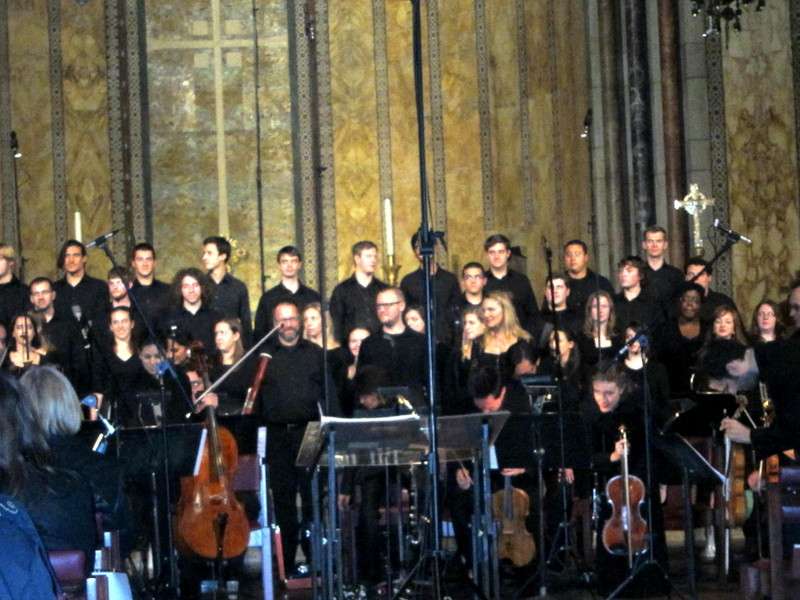|
Back
The Fierce Clash of Two Centuries New York
St. Bart’s Church
10/27/2012 -
“The Seven Spaces of Mozart’s Requiem”
Wolfgang Amadeus Mozart: Andante for Flute and Orchestra, K. 315 –
Requiem, K. 626
Georg Friedrich Haas: Sieben Klangräume
Paula Robison (Flute), Tharanga Goonetilleke (Soprano), Silvie Jensen (Alto), Steven Wilson (Tenor), Peter Steward (Bass)
College of New Jersey Chorale, John P. Leonard (Director), The Argento Chamber Ensemble, Michael Galante (Conductor)

Argento/TNJC at St. Bart’s (© Coco.T.Dawg)
For New Yorkers who abhor the jocular commercialization of Halloween, the more serious-minded Day of the Dead has been well covered.
Last week, Yannick Nézet-Séguin’s Verdi Requiem showed at how lustrous Heaven and Hell can be. Last night was an entirely different Requiem. Mozart’s original Mass for the Dead work was doubly shocking, doubly unnerving.
The first shock should have been expected. Conductor Michael Galante did not use the familiar sugar-coated “completion:” of the Requiem–actually a do-over–by Franz Xaver Süssmayr. Unlike, say, Turandot, where essentially only the finale was missing, Mozart wrote only one-third of his commission. (Though what a third!!) Rather than seeing it go into the garbage, Süssmayr rewrote, composed, and extended it to the work we know today.
Still, it was unsettling to hear only nine bars of the Lachrymosa, and the Offertory, no Sanctus, no Agnus Dei, no great final fugue–since Mozart never composed any of this.
At the least, hearing the original Requiem manuscript was like reading fragments of Sappho, Wonderful, with a potential for the miraculous. At the most, the music was like a heavenly body wandering eternally, without orbit or plan, through our universe.

G. F. Haas (© Harry Rolnick)
The second shock was a questionable gift from one century to another. That singular composer Georg Friedrich Haas, certainly one of the most fascinating writers today, made no attempt to “complete” the Requiem. Instead, he donated to his 18th Century fellow Austrian the 21st Century gifts of angst, disquiet, fear, psyche, Id, Superego and neurosis.
And Mr. Haas would have been derelict if he hadn’t brought that into this Requiem, for he is a man who understands the problems–artistic and personal–of our times. Like Luciano Berio “composing” a Schubert symphony from notes and from his own sense of music, Mr. Haas took seven uncompleted fragments from Mozart’s notebooks, and brought them into his own schematic of the work.
He also included other works, most notably, words from Mozart’s letters written during his final years. While unable to hear them myself, even from the excellent College of New Jersey Chorale, the Haas notes mentions that this is part of his own “sound world.”
These seven “sound spaces” were not Mozart notes extended or changed. Mr. Haas used electronic noises, from tapping to white massive sounds. He used his chorus to sing with consonant. recognizable (and very dense) music to screams, sheerly dissonant, to the kind of shouting-singing which is so powerful in the Penderecki Passion..
For the third “sound space”, both orchestra and electronic sound dwelt on a single note, seemingly incessant, until developed turning infernally loud. For another, the chorus called out with brass choirs. And finally, after the incomplete Hostias et Precess, where we had expected that grand fugue, the Mozart dropped out, and Haas did his own completion, softly going into the distance.
Hearing the first two pieces interpolated directly into the Requiem was admittedly distressing at first. The contrasts were too sharp, the familiar “religiosity” l was whirled about in a Time Machine, and we had to accustom ourselves not to dissonances, but to dissonances which diverted. from the original.
It was like reading a Hans Christian Andersen fairy tale, discovering that the little mermaid was sold into a brothel, or that the ugly duckling was cooked into succulent stew.
By the third sound space, I for one was ready–and more than willing–to let my mind travel through Mr. Haas’s wormhole, from 1791 to 2012 without anything in between. After all, music must be an astonishing surprise. Lest it not work.
Whether it be Haas transforming Mozart or James Levine transforming Beethoven’s Fifth, the effect must be memorable. Which, in this case, is was.
The College of New Jersey Chorale did the piece proud. While I could never catch all the words (St. Bart’s Church is filled with reverb), they had superlative voices. The soloists, especially soprano Tharanga Goonetilleke, were equally good. The Argento Chamber Ensemble had the right Mozart dimensions as well.
I was not terribly entranced with Michael Galante’s conducting. The first work, a Mozart Andante for flute, had a fine soloist in Paula Robison, but Mr. Galante let the tempo waver. Nor did he add that tension, that urgency for the first movements of the Requiem.
But Mr. Galante had an almost impossible job, augmenting Mozart’s familiar mystery to the intensity, cries, whispers, screams and cosmos of Georg Friedrich Haas. His success must be counted reasonably revelatory.
Harry Rolnick
|